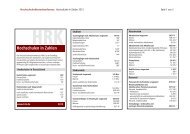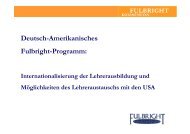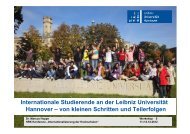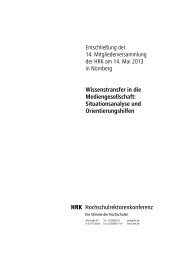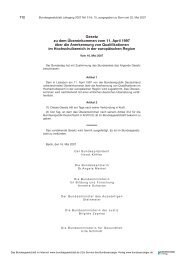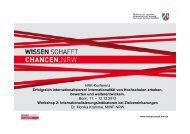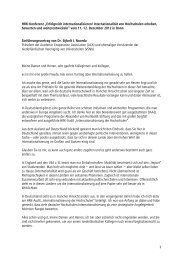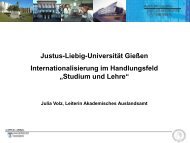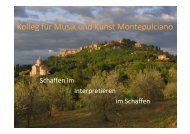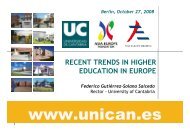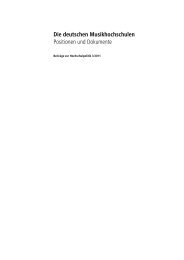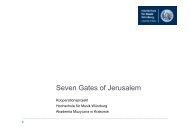Dr Richard Hopper
Dr Richard Hopper
Dr Richard Hopper
- TAGS
- richard
- hopper
- www.hrk.de
Create successful ePaper yourself
Turn your PDF publications into a flip-book with our unique Google optimized e-Paper software.
Regional Regional Cooperation Cooperation in<br />
Quality Quality Assurance Assurance in<br />
Higher Higher Education Education<br />
<strong>Richard</strong> <strong>Richard</strong> <strong>Hopper</strong><br />
Senior Education Education Specialist Specialist<br />
The World Bank<br />
Bonn, Germany Germany<br />
18 June 2007
What is a public good? good?<br />
• Non-excludable<br />
Non-excludable<br />
– No one can be barred from benefits benefits<br />
– No single purchaser purchaser<br />
•Non-rival<br />
•Non-rival<br />
– Can be consumed consumed without depletion depletion
Externalities<br />
Externalities<br />
• Higher education education quality assurance assurance produces produces<br />
important important externalities<br />
externalities<br />
– Difference Difference between between public and private benefits benefits<br />
– Hard to measure measure<br />
– Often expressed expressed as desirable desirable and durable attributes attributes<br />
• Benefits Benefits are diffuse<br />
– Employers Employers and society benefit from a better<br />
educated educated workforce, workforce, civil society, society, and populace populace<br />
– Producers Producers of goods and services services also benefit from<br />
educated educated consumers<br />
consumers<br />
• Benefits Benefits of quality assurance assurance cannot be limited<br />
to the individuals, individuals, institutions, institutions, or countries countries<br />
that undertake undertake the exercise exercise<br />
– “Free rider” problem problem in higher education education is<br />
complicated complicated by international international reach of the benefits<br />
– National National markets markets tend to underproduce underproduce public goods,<br />
so the international international community community has role
Quality Quality assurance assurance viewed viewed as<br />
• National National policies are key<br />
a public good<br />
– Governments Governments often struggle struggle to develop develop such policies<br />
– We need only look to issues like HIV, GM foods, etc.<br />
• Yet, global challenges challenges require new approaches<br />
approaches<br />
and frank debate<br />
– Many players are public sector institutions<br />
institutions<br />
– New actors & mechanisms<br />
mechanisms<br />
– Civil society<br />
– Private sector<br />
– International International and regional regional cooperation<br />
cooperation<br />
– Cross-sectoral Cross-sectoral linkages linkages
The World Bank<br />
• Created Created in 1944 to lend and grant<br />
money to governments governments to help them<br />
reconstruct reconstruct infrastructure infrastructure and systems systems<br />
devastated devastated by WWII<br />
– With the demise of colonialism colonialism and<br />
increased increased country country independence, independence, the Bank’s<br />
mandate mandate shifted to focus on loans and<br />
grants to developing developing countries countries<br />
– In 2007 there are 185 member member countries countries<br />
• Donor and borrowing borrowing counties counties<br />
– Mission: Mission: Poverty Poverty reduction reduction
Lending Lending operations<br />
operations<br />
• Lending Lending to national national governments governments is the<br />
core mechanism mechanism through through which the<br />
World Bank operates operates<br />
– The Bank also conducts conducts studies, studies, dialogue, dialogue,<br />
strategy strategy development, development, and provides provides<br />
technical technical assistance<br />
assistance<br />
• Yet there are also various grant mechanisms mechanisms at<br />
the Bank’s disposal disposal to achieve achieve its mandate mandate of<br />
poverty poverty reduction reduction and capacity capacity building building for<br />
development<br />
development<br />
– Lending Lending requires requires the Bank to work with nation<br />
states and has limitations limitations that complicate complicate multicountry,country,<br />
regional, regional, or global initiatives initiatives that are<br />
important important to expanding expanding global public goods
• Nation state model<br />
Regional Regional Programs Programs<br />
– Bi-lateral, Bi-lateral, multi-lateral, multi-lateral, and other aid agencies agencies operate operate mostly on the<br />
nation state model<br />
• Relationships Relationships are straightforward<br />
straightforward<br />
• Legal agreements agreements are customary<br />
customary<br />
• Design is simplified simplified<br />
• Beneficiaries Beneficiaries are clear<br />
• Recent evaluations evaluations underscore underscore the important important benefits benefits of regional regional<br />
programs programs<br />
– Most reach their development development objectives<br />
objectives<br />
– Cooperation Cooperation and sharing<br />
– Integration Integration and harmonization<br />
harmonization<br />
– Value-added<br />
Value-added<br />
– Economies Economies of Scale<br />
• Yet regional regional programs programs represent represent >3% of development development support support<br />
worldwide<br />
worldwide<br />
– The World Bank notes a difference difference in outcomes outcomes between between regional regional lending<br />
programs programs and regional regional partnership partnership programs programs (such as the DGF)<br />
• Lending Lending programs programs have strong country voice<br />
• Partnerships Partnerships dominated dominated by NGOs with weak links to national national institutions<br />
institutions<br />
– An impediment impediment to build knowledge knowledge support for national national policy reforms reforms<br />
• Partnerships Partnerships lack good resource resource mobilization mobilization plans to ensure financial financial predictability<br />
predictability<br />
and sustainability sustainability once external external support support ends
Global Global partnerships partnerships to<br />
leverage leverage effectiveness<br />
effectiveness<br />
• The World Bank, (IBRD and IDA), lends $20 billion each year<br />
– To promote promote economic economic growth and social progress progress in the<br />
developing developing world<br />
• IBRD lends largely to middle-income middle-income developing developing countries countries and finances finances<br />
its operations operations primarily primarily through through bond sales on world capital markets markets<br />
• IDA finances finances projects projects in the world's poorest countries countries and lends on<br />
concessional concessional terms, drawing drawing largely on contributions contributions from its wealthier wealthier<br />
member member countries. countries.<br />
• The Bank also mobilizes mobilizes resources resources to help finance non-lending non-lending technical technical<br />
assistance assistance activities activities to meet the special needs of developing developing countries countries<br />
and emphasizes emphasizes its guarantee guarantee instruments instruments as a catalyst catalyst for private<br />
capital flows.<br />
• The Bank supports supports its efforts by forging effective effective partnerships<br />
partnerships<br />
with the members members of the international international development development and<br />
financial financial community.<br />
community.<br />
– In addition addition to mobilizing mobilizing contributions contributions from donor governments<br />
governments<br />
directly, directly, it works with a broad array of private and public<br />
institutions.<br />
institutions.<br />
– Often, the Bank also co-finances co-finances its projects projects with governments,<br />
governments,<br />
commercial commercial banks, export credit agencies, agencies, multilateral multilateral institutions,<br />
institutions,<br />
private sector investors, investors, and NGOs.
Development Development Grant Facility Facility<br />
(DGF) (DGF)<br />
• Established Established in 1998 as Bank’s mechanism mechanism to<br />
support support global and regional regional programs programs to build<br />
capacity capacity in ways that are not possible possible through through<br />
country country operations.<br />
operations.<br />
– Encourage Encourage innovation<br />
innovation<br />
– Catalyze Catalyze institutional institutional partnerships<br />
partnerships<br />
• Each proposal proposal must have a Bank sector<br />
sponsor sponsor to vet proposals proposals prior to submission<br />
submission<br />
to ensure that they align with Bank and sector<br />
priorities priorities<br />
• Adjust programs programs under supervision<br />
supervision
Criteria Criteria for DGF support support<br />
• Subsidiarity Subsidiarity – promotes promotes Bank goals<br />
• Comparative Comparative advantage advantage – does not replicate replicate<br />
work of other donor agencies agencies<br />
• Multi-country Multi-country benefits benefits<br />
• Leverage Leverage – to attract other financial financial resources resources<br />
• Managerial Managerial competence competence – given to an<br />
institution institution with a record of achievement achievement in<br />
program program area and financial financial probity<br />
• Arm’s length relationship relationship to Bank<br />
• Disengagement Disengagement strategy strategy<br />
• Promoting Promoting or reinforcing reinforcing partnerships<br />
partnerships
DGF support support for regional regional<br />
networks networks in quality quality<br />
assurance<br />
assurance<br />
• Asia Pacific Quality Network Network (APQN)<br />
• Latin America America Network Network for Quality Assurance<br />
Assurance<br />
in Higher Education Education (RIACES) (RIACES)<br />
• Association Association of African Universities Universities (AAU)<br />
• Global Initiative Initiative for Quality Assurance<br />
Assurance<br />
Capacity Capacity (GIQAC) (GIQAC)<br />
– Subsumes Subsumes RIACES, RIACES, AAU and adds the Arab Network Network<br />
for Quality Assurance Assurance in Higher Education Education<br />
– Opens the door for funding to APQN, CEE-Net, CEE-Net, and<br />
other regional regional networks networks<br />
– Seeks to build capacity capacity of INQAAHE INQAAHE to support support<br />
capacity capacity building building for QA in developing developing countries countries
Recent Recent IAD and QAG reviews reviews<br />
• … have altered the Bank’s approach approach to<br />
management management capacity capacity of DGFsupportedsupported<br />
initiatives…<br />
initiatives…<br />
– From compliance compliance to capacity capacity<br />
– From transactions transactions to systems systems<br />
– From projects projects to institutions<br />
institutions<br />
– Toward a focus on risk<br />
– Toward partnerships partnerships with institutions institutions whose<br />
systems systems meet standards standards at entry<br />
• Able to withstand withstand increased increased scrutiny scrutiny of controls controls
Global Global Initiative Initiative for Quality Quality<br />
Assurance Assurance Capacity Capacity (GIQAC) (GIQAC)<br />
• Proposed Proposed World Bank partnership partnership with UNESCO UNESCO<br />
– Window Window 2 funding<br />
– Focus on developing developing countries countries<br />
– To build quality assurance assurance capacity capacity<br />
– UNESCO UNESCO generously generously offered to host GIQAC secretariat<br />
secretariat<br />
– GIQAC as an umbrella umbrella for programmatic programmatic support support to:<br />
• INQAAHE INQAAHE<br />
• Regional Regional networks networks for quality assurance assurance<br />
– Not to duplicate duplicate the work of INQAAHE, INQAAHE, but to complement<br />
complement<br />
it and help to build the capacity capacity of INQAAHE INQAAHE to play a<br />
more significant significant role in building building QA capacity capacity in developing<br />
developing<br />
countries countries<br />
– Prior DGF agreements agreements (RIACES (RIACES and AAU) will be ringfenced<br />
in the DGF legal agreement agreement with UNESCO UNESCO<br />
– Opens the door to other regional regional networks networks not yet<br />
beneficiaries beneficiaries of prior DGF funds (CEE-net, (CEE-net, EAQAN, EAQAN,<br />
CANQATE, CANQATE, CAMES, CAMES, HEQMISA, HEQMISA, etc.)



